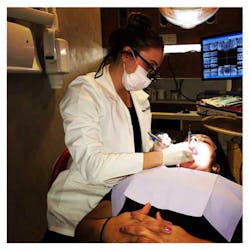A review of nonsurgical periodontal therapy
Nonsurgical periodontal therapy (NSPT) consists of scaling and root planing with local anesthesia to provide patient comfort. As defined by the American Academy of Periodontology to the public:
Scaling and root planing is a careful cleaning of the root surfaces to remove plaque and calculus [tartar] from deep periodontal pockets and to smooth the tooth root to remove bacterial toxins. Scaling and root planing is often followed by adjunctive therapy such as local delivery antimicrobials and host modulation, as needed on a case-by-case basis. (1)
NSPT initially eradicates the bacteria, but proper home care and frequent maintenance appointments are imperative in the preservation of the periodontal response and stabilization period. Bacteria have been shown in studies to recolonize teeth after removal anywhere from six to eight weeks later. (2) Proper maintenance and patient hygiene plays a large role in suppression of recolonization. Dependent upon the degree of severity, patient tooth anatomy, and hygiene control the patient’s maintenance schedule, which needs to be tailored accordingly.
ADDITIONAL READING |Treating implant gingivitis
Daily home care and frequent recall are still paramount for long-term success. Nonsurgical therapy remains the cornerstone of periodontal treatment. Attention to detail, patient compliance, and proper selection of adjunctive antimicrobial agents for sustained plaque control are important elements in achieving successful long-term results. (3)
Although NSPT is effective, it does have its limitations. The patient’s degree of periodontal involvement, social factors (i.e., smoking), systemic health (i.e., diabetes), genetics (i.e., family history of periodontal disease), tooth anatomy (i.e., furcations, enamel projections), restorative anatomy (i.e., overhang restorations) and home hygiene care can determine how effective NSPT will be. After the intial scaling/root planing is completed, reevaluation of the periodontal tissues should be done four to six weeks later. (4) If the tissues remained inflamed and the sulcus is still pocketing, referral to the periodontist should be performed. Access flaps and open flap debridement procedures may be necessary to fully remove the bacteria and calculus. In addition certain bony defects may be able to be corrected with guided tissue regeneration procedures using bone grafts and barrier membranes. Knowledge of these advanced techniques should be known by both dentist and hygienist in order to speak to the patient informatively prior to the referral.
References
1. http://www.perio.org/consumer/non-surgical
2. Sbordone L, et al. Recolonization of the subgingival microflora after scaling and root planing in human periodontitis. Sept. 1990; 61(9): 579-584.
3. Drisko C. Nonsurgical periodontal therapy. Periodontol 2000. 2001;25:77-88.
4. Caton JG, Zander HA. The attachment between tooth and gingival tissues after periodic root planing and soft tissue curettage. J Periodontol. Sept. 1979; 50(9):462-466.


